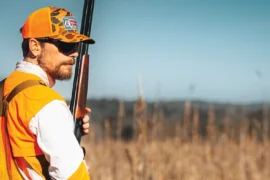From our July/August 2025 Issue
The premise was simple: Take three guides with proven cover dogs; team them with six experienced wingshooters; drop them all in an area they’ve never hunted before; and, with the help of one of today’s most advanced hunting technologies, see if they can find and shoot birds.
What could be so hard about that? I thought when invited to join the group. Then I was told what we’d be hunting: ruffed grouse—one of the upland’s most elusive gamebirds. That certainly ratcheted up the difficulty factor but also the intrigue. Who wouldn’t want to learn how to become a better grouse hunter? Challenge accepted!
So late October I flew from Portland, Maine, to Minneapolis, Minnesota, where I met part of our group for the four-hour drive through Duluth and up Lake Superior’s north shore to the city of Grand Marais. There, we took the Gunflint Trail for the final hour’s drive to Gunflint Lodge, hard against the Canadian border.
After unpacking and stowing gear, the entire group met in the main cabin for a meet-and-greet and to learn more about the “secret tech weapon” we’d be employing: the onX Hunt app. If you’re unfamiliar with it, onX is one of the most advanced and accurate 3D mapping technologies available. Downloaded onto a mobile device, it shows public- and private-land boundaries and ownership details, allows you to track your location using your smartphone’s built-in GPS, offers customizable mapping tools and more. I had been using onX for years for things like locating property lines and marking bird coverts, but it turned out I’d only been scratching the surface of the app’s capabilities.
I learned this when onX Marketing Manager Ben Brettingen, one of the hosts of the trip as well as one of the guides, gave us a crash course in using the app to scout for grouse. A key, it turns out, is using map layers, which are color-coded overlays that allow you to see multiple features at the same time. By toggling on different layers, you can see things like regenerating timber cuts and young aspen stands—key habitat types for ruffed grouse.
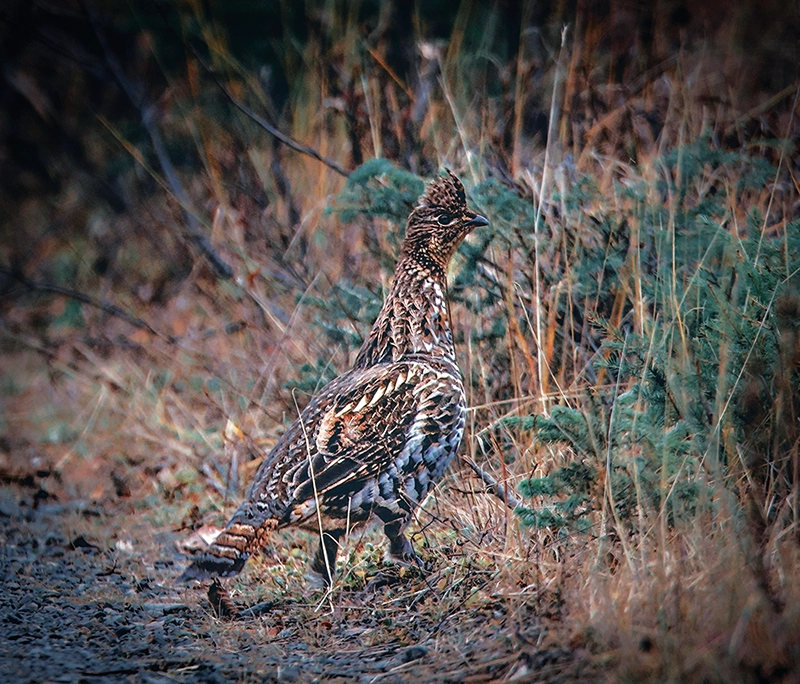
According to Ben: “The key to finding the most productive grouse covers is diversity. Grouse can utilize various habitat types depending on the day, so identifying areas that check multiple boxes can lead to more-successful hunts. One of the first things I look for is high stem density, and the best way to locate these areas is by using multiple onX imagery and layers to narrow down millions of acres to the exact spots worth hunting. In this region, early successional cover is often dominated by aspen, with logging and fire being the primary forces shaping the landscape. Ideally, you’ll find pockets of eight- to 20-year-old aspens interspersed with coniferous stands and lowland swampy areas. However, the optimal age of aspen stands varies based on soil conditions and geography. A cut in southern Michigan might be prime at seven years old, whereas in Canada it could take 20 years to reach peak grouse habitat.”
For a confessed luddite like me, the information was a bit overwhelming; but because the app is very intuitive, I was able to get up to speed quickly. Armed with this advice and having downloaded offline maps in anticipation of having spotty cell service, the group retired in anticipation of the hunt.
The next day following breakfast, we split into three groups. I was paired with Thacher Stone, the owner of Bird Dog Public Relations and the other host of the trip. Our guide was Ryan Hough, a member of the Minnesota Grouse Dog Association. Ryan trains and breeds English setters for hunting and trialing and has a string of proven bird finders.
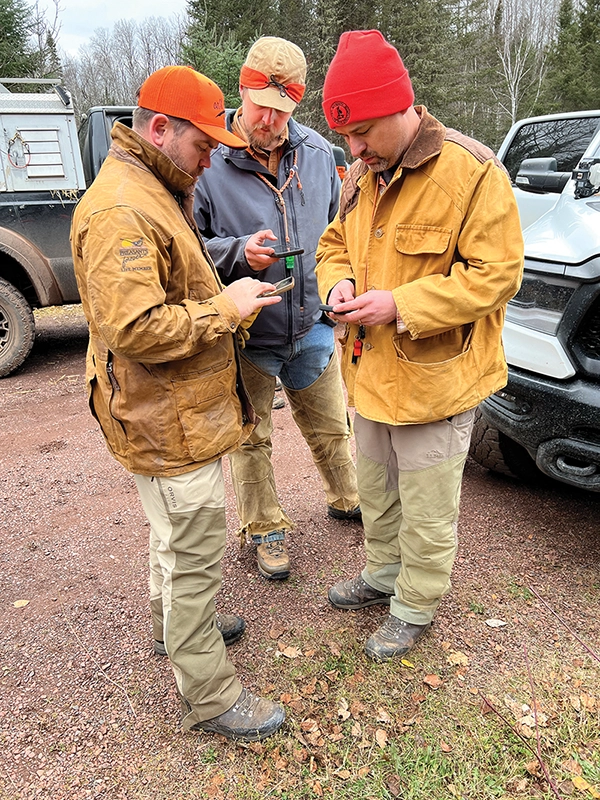
Still, this was a new area for all of us, and the boreal forest of northeastern Minnesota is vastly different from the central and northwestern parts of the state Hough was used to hunting. In addition, the area had been experiencing prolonged drought, impacting cover and food sources and making scenting conditions for the dogs difficult.
As we drove around, Thacer, a fellow grouse hunter from Maine, and I searched for familiar-looking cover. Minnesota’s northeastern Arrowhead Region, so named because of its shape, is quite rugged, with numerous lakes and dense stands of aspen, birch, spruce, fir and pine. It also is checkerboarded with different ownership groups, from federal, state and county to tribal and private. This made having onX especially valuable, as not only could we see cover types, but we also could tell where we were and weren’t allowed to hunt.
Using our phones and intuition, we eventually found several likely-looking coverts and went on extended walks. Ryan’s setters made valiant efforts but got birdy only a few times. Unfortunately, this was the day the drought decided to end, and rain drove us back to camp for lunch. In the afternoon we returned to the field, but the rain intensified and we eventually called it quits.

That evening we heard similar tales of disappointment from the other groups, as there had been only a few bird contacts and no grouse taken.
The second day I was teamed with Derek Horner, the Manager of Audience Development for Outdoor Life, and guide AJ Kalupa, owner of High Point Setters, in Big Lake, Minnesota. To change things up, the entire group decided to spread out, so our team drove about an hour south to an area dotted with lakes and mixed habitat.
The temperature was cooler this morning and showers quit early, but despite the improved conditions, we still had trouble finding birds. AJ’s setters worked well in what appeared to be perfect cover: a mix of different-age-class timber cuts, aspen stands, swamps and pine forests. They got birdy a few times and we thought we heard several grouse flush, but there were no solid points or shots.
Everyone rendezvoused for lunch at a picnic area, and we were heartened to learn that Ben’s hunters had taken a couple of birds. While the rest of us scoffed down freshly made burritos, the guides took out their phones and compared notes. They also opened the crops of the grouse and found that the birds had been eating greens, including wood fern, clover and wild strawberry leaves, along with hazel catkins, rose hips and high-bush cranberries. Hopefully these clues would help narrow the search.
In the afternoon we set off with renewed enthusiasm. AJ, Derek and I opted to take an extended hike and hit a large tract of timber crisscrossed by logging roads. Again AJ’s setters were relentless, thoroughly covering ground and eventually stretching out farther and farther. This time we did get a couple of points, but before we could get closer than 75 yards, we heard the grouse blow out.
On the way back to the truck, we watched a grouse flush from the trail into a large pine tree. Derek put the sneak on it, and when the ruff dove from the limb, Derek fired. He and I both thought he connected, but neither we nor the dogs could come up with the bird.
That evening we learned that Ben’s hunters had taken two more grouse and that Ryan’s team had had several bird contacts and missed opportunities. It felt like everyone was getting closer to putting the pieces together.
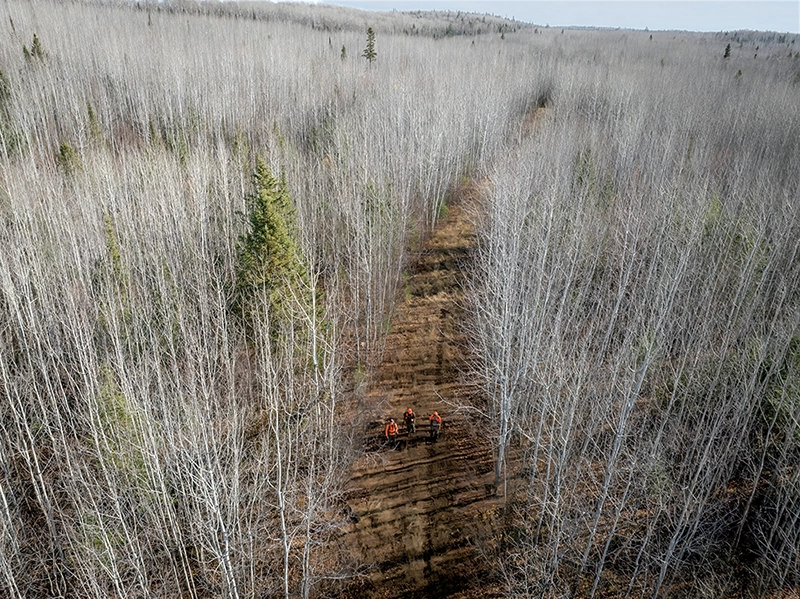
The third and final morning I hunted with Ben and Kali Parmley, the Editor in Chief and Associate Publisher of Gun Dog Magazine. Kali was being filmed for her TV show Wild Upland, so we had videographers Brent Robert and Chris Collins with us as well as photographer Matt Addington. It was a large crew, but we still managed to cover plenty of ground behind one of Ben’s pointers and one of Kali’s setters.
Ben had found the sweet spots to be 10- to 12-year old timber cuts grown up to aspen, so we worked the edges of those areas as well as swampy thickets near mature timber. Oddly, the grouse seemed to be hopping into trees that morning, and the several times the dogs went on point, the birds flushed high, never offering a shot.
After lunch Kali and Ben had to do more filming, so I jumped in with my team from the first day: Ryan and Thacher. We headed to a spot where Ryan had found birds the previous day and let out his setter Patti. The cover was a mosaic of mature timber with thick understory, young aspen stands and moist lowlands.
We had walked about a half-mile when Patti pointed at the edge of a steep drop-off. Before we could get close, however, several grouse blew out of the treetops and scattered.
Patti headed off again, and five minutes later Ryan’s handheld indicated that she was pointing 155 yards away. A logging road brought us close to her, but by the time we arrived, the bird had moved off. I stayed on the road as Thacher and Ryan walked in, and Ryan released Patti to begin tracking toward a swamp edge. It turned out that we had the grouse pinned, and when it panicked ot flight, it burst across the road and I tumbled it into the woods on the other side. Success!
A hundred yards farther Patti pointed again. This time it was a running woodcock, and Thacher was able to flush and drop it amongst some dense whips.
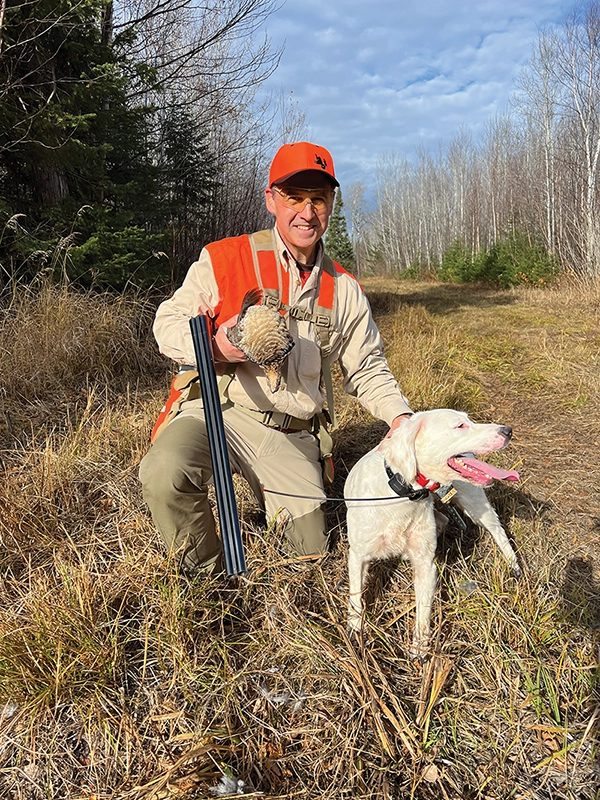
We made a long loop back to the truck, and though Patti found several more grouse, none offered a shot. At least we were getting into birds.
With time for one last hunt, we headed for an overgrown gravel pit that looked promising. According to onX, the area was surrounded by patches of young alders, and there was a 10-year-old timber cut at the back end. Ryan put a bell and collar on his setter Libby and turned her loose.
It didn’t take long for Libby to confirm that our hunch was correct, as she locked up in thick alders at the base of a berm. When we walked in, a grouse got up and scooted over the rise, evading Thacher’s shot. We followed up, and 50 yards farther the grouse clattered up again, offering me a decent chance that I muffed.
We continued pushing through thick alders, with Libby pointing and relocating, tracking running birds. A woodcock got up wild to my left, and I dropped it in a swale. Eventually Libby pinned a grouse at the top of a hill in an old cut, but the bird let us walk past before thundering out from the hollow of a dead oak. I spun and tried to take the grouse zipping through the treetops but couldn’t catch up.
By then the light was fading, so we started heading back. When we were within sight of the truck, Thacher saw a grouse flutter up from the road. We slowly approached the spot, searching the trees, but it wasn’t until we stepped into the woods that the grouse pitched out of a spruce and made good its escape.
At camp that evening there was plenty to celebrate. Our late-day activity had been proof positive that onX can be a great tool for helping find birds. AJ and his hunters had had a banner day, as well, taking seven grouse and finding many more. We all agreed that, had it not been for the app, our quest would have been exponentially more difficult.
Of course, we also proved that just because you can find grouse doesn’t mean you can hit them. But I’m sure that there’s an app to fix that . . . .
Read our Newsletter
Stay connected to the best of wingshooting & fine guns with additional free content, special offers and promotions.



